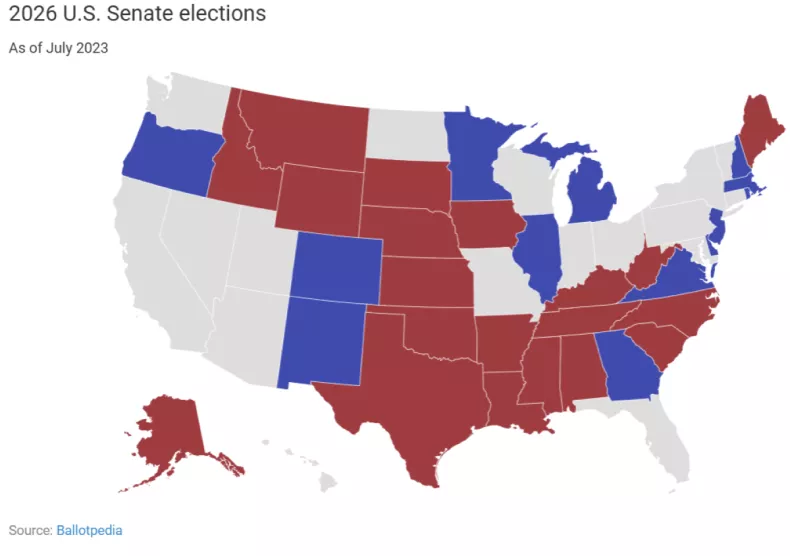By Mandy Taheri Newsweek Weekend Reporter (translated using Google translate)
共和党于周二控制了参议院,这为民主党在 2026 年克服困难创造了条件。
本周早些时候,共和党在西弗吉尼亚州、俄亥俄州和蒙大拿州夺得了三个参议院席位,使参议院的控制权从民主党手中移开。截至周五,共和党拥有 52 个参议院席位,民主党拥有 45 个。
在本周选举之前,民主党以微弱优势占据 51 个席位(包括四名与该党一起参加党团会议的独立人士),而共和党拥有 49 个席位。
周二,民主党在所有政治竞选中都落后于共和党,当选总统唐纳德·特朗普赢得白宫,共和党获得参议院多数席位,共和党可能在众议院保持共和党多数席位。截至周五上午,并非所有众议院竞选都已宣布。
与众议院候选人每两年换届一次不同,参议员任期为六年。
参议院有 33 个席位将于 2026 年 11 月 3 日举行选举。其中,20 个由共和党人担任,13 个由民主党人担任。
以下各州将在当年举行参议院席位选举:阿拉巴马州、阿拉斯加州、阿肯色州、科罗拉多州、特拉华州、乔治亚州、爱达荷州、伊利诺伊州、爱荷华州、堪萨斯州、肯塔基州、路易斯安那州、缅因州、马萨诸塞州、密歇根州、明尼苏达州、密西西比州、蒙大拿州、内布拉斯加州、新罕布什尔州、新泽西州、新墨西哥州、北卡罗来纳州、俄克拉荷马州、俄勒冈州、罗德岛州、南卡罗来纳州、南达科他州、田纳西州、德克萨斯州、弗吉尼亚州、西弗吉尼亚州和怀俄明州。

要在 2026 年扭转参议院局面,民主党需要赢得全部 13 个席位并扭转至少另外 3 个席位。
虽然民主党有办法获得多数席位,但目前看来他们的可能性不如共和党保持领先。
以下各州很可能在 2026 年参议院选举中展开关键角逐。
可能翻转的席位
缅因州
缅因州是一个政治分裂的州,共和党参议员苏珊·柯林斯和独立参议员安格斯·金代表该州,该州由民主党州长珍妮特·米尔斯领导。
自 1997 年以来,柯林斯一直代表该州。她被认为是一位温和的共和党人,在唐纳德·特朗普的第一任期内公开反对他。
在她最近的一次选举中,即 2020 年,她以 51% 的选票赢得了席位,民主党挑战者获得了 42.4% 的选票。 2014 年,她以更大的优势获胜,67% 对 30.8%。
缅因州参议院席位可能是民主党翻转共和党席位的潜在途径,但考虑到柯林斯的长期选举历史和支持,这不太可能。
北卡罗来纳州
共和党参议员 Thom Tillis 在该州参加过两次竞争激烈的选举,2014 年他首次赢得该席位,得票率为 48.8%,民主党参议员 Kay Hagan 的得票率为 47.3%。
2020 年,Tillis 获得 48.7% 的选票,再次赢得该席位。
鉴于北卡罗来纳州的分票历史,最近一次是在本周的选举中,当时大多数选民支持特朗普担任总统,民主党人 Josh Stein 担任州长,民主党人可能会试图翻转该州。
可能争夺民主党席位
佐治亚州
2020 年,民主党候选人 Jon Ossoff 在参议院决选中击败参议员 David Perdue,赢得激烈竞争。Ossoff 以 50.6% 的得票率击败 Perdue 的 49.4%,最终赢得该席位。
奥索夫将于 2026 年竞选连任,预计将与共和党候选人展开激烈竞争。要扭转参议院局面,民主党必须保住奥索夫的席位,尽管这可能是一场激烈的竞争。
密歇根州
民主党参议员加里·彼得斯于 2015 年上任,以 13.3 个百分点的优势击败共和党挑战者。2020 年,他以 49.9% 的微弱优势再次当选,共和党候选人的支持率为 48.2%。
由于彼得斯当年的胜选优势缩小,共和党可能会努力扭转这一席位。确保他在 2026 年的席位对于民主党重新控制参议院至关重要。
新罕布什尔州
民主党参议员珍妮·沙欣自 2009 年以来一直担任新罕布什尔州参议员。2020 年,她以超过 15 个百分点的领先优势获得该席位,而在 2014 年,她的竞争更加激烈,以 51.5% 的得票率击败共和党挑战者的 48.2%。
民主党需要保住新罕布什尔州的席位才能扭转参议院的局面。
虽然新罕布什尔州有两名民主党参议员,但该州州长克里斯·苏努努和立法机构都是共和党人。
弗吉尼亚州
民主党参议员马克·沃纳于 2009 年上任,并将于 2026 年竞选连任。他在 2014 年以 49.1% 的得票率险胜共和党挑战者的 48.3% 的得票率获得该席位。
2020 年,他以 56% 的得票率赢得了该州。
Republicans clinched control of the Senate on Tuesday, setting up a challenging situation for Democrats to overcome in 2026.
Earlier this week, Republicans flipped three Senate seats in West Virginia, Ohio and Montana, tipping the chamber's control away from the Democrats. As of Friday, the Republicans have 52 Senate seats and the Democrats 45.
Before this week's election, Democrats held a narrow majority of 51 seats (including four independents who caucus with the party), while the Republicans had 49.
Democrats trailed Republicans in all political races on Tuesday, with President-elect Donald Trump winning the White House, Republicans securing a Senate majority and the GOP possibly maintaining a GOP majority in the House. Not all House races have been called as of Friday morning.
Unlike the House, where candidates are up for reelection every two years, senators serve six-year terms.
Thirty-three Senate seats are open for election on November 3, 2026. Of those, 20 are held by Republicans and 13 by Democrats.
The following states will have Senate seats up for election that year: Alabama, Alaska, Arkansas, Colorado, Delaware, Georgia, Idaho, Illinois, Iowa, Kansas, Kentucky, Louisiana, Maine, Massachusetts, Michigan, Minnesota, Mississippi, Montana, Nebraska, New Hampshire, New Jersey, New Mexico, North Carolina, Oklahoma, Oregon, Rhode Island, South Carolina, South Dakota, Tennessee, Texas, Virginia, West Virginia and Wyoming.

To flip the Senate in 2026, Democrats would need to win all 13 seats and flip at least three others.
While there are paths for Democrats to secure the majority, they currently seem less likely than Republicans holding their lead.
The following states are likely to have key races in the 2026 Senate elections.
Potential Seats to Flip
Maine
Maine is a political split state, with Republican Senator Susan Collins and independent Senator Angus King representing the state, which is led by Democratic Governor Janet Mills.
Collins has represented the state since 1997. She is considered a moderate Republican who spoke out against Donald Trump during his first term.
In her most recent election, in 2020, she won the seat with 51 percent of the vote, with the Democratic challenger garnering 42.4 percent. In 2014, she won by an even larger margin, 67 percent to 30.8 percent.
The Maine Senate seat could be a potential path for Democrats to flip a Republican seat, but given Collins' long electoral history and support, it is unlikely.
North Carolina
Republican Senator Thom Tillis has had two competitive elections in the state, having won the seat originally in 2014, 48.8 percent to Democrat Senator Kay Hagan's 47.3 percent.
In 2020, Tillis secured 48.7 percent of the vote, winning the seat again.
Given North Carolina's history of ticket splitting, most recently seen in this week's elections when a majority of voters backed Trump for president and Democrat Josh Stein for governor, it is possible Democrats could try to flip the state.
Potentially Contested Democrat-Held Seats
Georgia
In 2020, Democratic candidate Jon Ossoff won a tight Senate runoff election against Senator David Perdue. Ossoff clinched the seat by garnering 50.6 percent to Perdue's 49.4 percent.
Ossoff, who will run for reelection in 2026, is expected to face a tight race against a Republican candidate. To flip the Senate, it would be crucial for Democrats to keep Ossoff's seat, although this is likely to be a closely contested race.
Michigan
Democratic Senator Gary Peters took office in 2015, beating out the Republican challenger by 13.3 percentage points. In 2020, he was reelected by a much tighter margin, 49.9 percent to the Republican candidate's 48.2 percent.
Because Peters' victory margin shrank that year, this is a seat Republicans might work to flip. Securing his seat in 2026 would be essential for the Democratic Party's regaining control of the Senate.
New Hampshire
Democratic Senator Jeanne Shaheen has held her seat in New Hampshire since 2009. In 2020, she secured the seat with an over 15-point lead, while in 2014 she had a closer race, winning 51.5 percent to a Republican challenger's 48.2 percent.
Democrats would need to keep the New Hampshire seat to flip the Senate.
While New Hampshire has two Democratic senators, the state's governor, Chris Sununu, and the Legislature are Republican.
Virginia
Democratic Senator Mark Warner assumed office in 2009 and will run for reelection in 2026. He narrowly secured the seat in 2014, with 49.1 percent of the vote versus his Republican challenger's 48.3 percent.
In 2020, he won the state with 56 percent of the vote.
